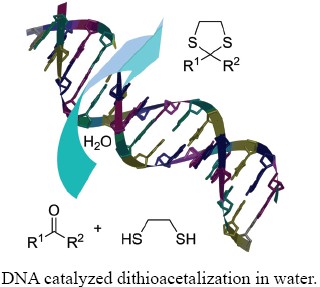| [1] Ralls, J. W.; Dodson, R. M.; Riegel, B. J. Am. Chem. Soc. 1949, 71, 3320.[2] Djerassi, C.; Gorman, M. J. Am. Chem. Soc. 1953, 75, 3704.[3] Aoyama, T.; Takido, T.; Kodomari, M. Synlett 2004, 2307.[4] Tani, H.; Masumoto, K.; Inamasu, T.; Suzuki, H. Tetrahedron Lett. 1991, 32, 2039.[5] Firouzabadi, H.; Karimi, B.; Eslami, S. Tetrahedron Lett. 1999, 40, 4055.[6] Moghaddam, F. M.; Bardajee, G. R.; Oskui, A. A. Phosphorus, Sulfur Silicon Relat. Elem. 2006, 181, 1445.[7] Shaterian, H. R.; Hosseinian, A.; Ghashang, M. Synth. Commun. 2008, 38, 4097.[8] Corey, E. J.; Seebach, D. Angew. Chem. Int. Ed. Engl. 1965, 4, 1075.[9] Seebach, D. Angew. Chem. Int. Ed. Engl. 1969, 8, 639.[10] Seebach, D. Angew. Chem. Int. Ed. Engl. 1979, 18, 239.[11] Li, C. J. Chem. Rev. 2005, 105, 3095.[12] Chanda, A.; Fokin, V. V. Chem. Rev. 2009, 109, 725.[13] Butler, R. N.; Coyne, A. G. Chem. Rev. 2010, 110, 6302.[14] Simon, M.-O.; Li, C.-J. Chem. Soc. Rev. 2012, 41, 1415.[15] Otto, S.; Bertoncin, F.; Engberts, J. J. Am. Chem. Soc. 1996, 118, 7702.[16] Li, H. J.; Zhao, J. L.; Chen, Y. J.; Liu, L.; Wang, D.; Li, C. J. Green Chem. 2005, 7, 61.[17] Fousteris, M.; Chevrin, C.; Le Bras, J.; Muzart, J. Green Chem. 2006, 8, 522.[18] Guizzetti, S.; Benaglia, M.; Raimondi, L.; Celentano, G. Org. Lett. 2007, 9, 1247.[19] Tandon, V. K.; Maurya, H. K. Tetrahedron Lett. 2010, 51, 3843.[20] Landelle, G.; Claraz, A.; Oudeyer, S.; Levacher, V. Tetrahedron Lett. 2012, 53, 2414.[21] Ceschi, M. A.; Felix, L. D.; Peppe, C. Tetrahedron Lett. 2000, 41, 9695.[22] Manabe, K.; Iimura, S.; Sun, X. M.; Kobayashi, S. J. Am. Chem. Soc. 2002, 124, 11971.[23] Dong, D. W.; Yan, O. Y.; Yu, H. F.; Liu, Q.; Liu, J.; Wang, M.; Zhu, J. J. Org. Chem. 2005, 70, 4535.[24] Karimi, B.; Khalkhali, M. J. Mol. Catal. A: Chem. 2007, 271, 75.[25] Weng, S.-S.; Chang, S.-C.; Chang, T.-H.; Chyn, J.-P.; Lee, S.-W.; Lin, C.-A.; Chen, F.-K. Synthesis 2010, 1493.[26] Rohman, M. R.; Rajbangshi, M.; Laloo, B. M.; Sahu, P. R.; Myrboh, B. Tetrahedron Lett. 2010, 51, 2862.[27] Bahrami, K.; Khodaei, M. M.; Tajik, M.; Soheilizad, M. J. Sulfur Chem. 2011, 32, 397.[28] Robertson, M. P.; Joyce, G. F. Cold Spring Harb. Perspect. Biol. 2012, 4, 1.[29] Bada, J. L.; Lazcano, A. Science 2002, 296, 1982.[30] Poole, A. M.; Jeffares, D. C.; Penny, D. J. Mol. Evol. 1998, 46, 1.[31] Lorsch, J. R.; Szostak, J. W. Acc. Chem. Res. 1996, 29, 103.[32] Gilbert, W. Nature 1986, 319, 618.[33] Pace, N. R.; Marsh, T. L. Origins Life Evol. Biosphere 1985, 16, 97.[34] Kruger, K.; Grabowski, P. J.; Zaug, A. J.; Sands, J.; Gottschling, D. E.; Cech, T. R. Cell 1982, 31, 147.[35] Guerriertakada, C.; Gardiner, K.; Marsh, T.; Pace, N.; Altman, S. Cell 1983, 35, 849.[36] Li, X. Y.; Liu, D. R. Angew. Chem. Int. Ed. 2004, 43, 4848.[37] Silverman, A. P.; Kool, E. T. Chem. Rev. 2006, 106, 3775.[38] Roelfes, G.; Feringa, B. L. Angew. Chem. Int. Ed. 2005, 44, 3230.[39] Boersma, A. J.; Megens, R. P.; Feringa, B. L.; Roelfes, G. Chem. Soc. Rev. 2010, 39, 2083.[40] Silverman, S. K. Angew. Chem. Int. Ed. 2010, 49, 7180.[41] Fan, J.; Sun, G.; Wan, C.; Wang, Z.; Li, Y. Chem. Commun. 2008, 3792.[42] Sun, G.; Fan, J.; Wang, Z.; Li, Y. Synlett 2008, 2491.[43] De Rosa, M.; Di Marino, S.; D'Ursi, A. M.; Strianese, M.; Soriente, A. Tetrahedron 2012, 68, 3086.[44] Wang, C.; Jia, G.; Zhou, J.; Li, Y.; Liu, Y.; Lu, S.; Li, C. Angew. Chem. Int. Ed. 2012, 51, 9352.[45] Wang, C.; Li, Y.; Jia, G.; Liu, Y.; Lu, S.; Li, C. Chem. Commun. 2012, 48, 6232. |
